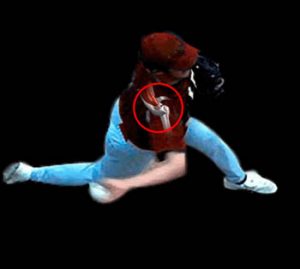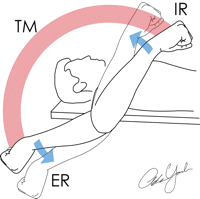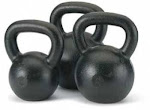Tuesday, April 26, 2011
Today's training.
Food for thought from Eric Cressey on Crossfit training for Baseball.
Written on September 14, 2009 at 7:25 pm, by Eric Cressey
I’ve received a lot of emails just recently (as well as some in-person questions) asking me what I think of Crossfit for baseball players and, more specifically, pitchers.
Let me preface this email with a few qualifying statements. First, the only exercise “system” with which I agree wholeheartedly is my own. Cressey Performance programming may be similar in some respects to those of everyone from Mike Boyle, to Louis Simmons, to Ron Wolforth, to the Crossfit folks – but taken as a whole, it’s entirely unique to me. In other words, I will never agree completely with anyone (just ask my fiancee!).

Second, in spite of the criticism Crossfit has received from some people I really respect, I do feel that there are some things they’re doing correctly. For starters, I think that the camaraderie and enthusiasm that typifies their training groups is fantastic; anything that gets people (who might otherwise be sedentary) motivated to exercise is a plus. Moreover, they aren’t proponents of steady-state cardio for fat loss, and they tend to gravitate toward compound movements. So, good on them for those favorable traits.
However, there are several issues that concern me with applying a Crossfit mentality to the baseball world:
1) The randomness of the “workout of the day” is simply not appropriate for a sport that has quite possibly the most specific sport-imposed asymmetries in the world of athletics. I’ve written about these asymmetries in the past, and they can only be corrected with specific corrective training modalities.
I’m reminded of this constantly at this time of year, as we get new baseball players at all levels now that seasons are wrapping up. When a player presents with a 45-degree glenohumeral internal rotation deficit, a prominent scapular dyskinesis, and a complete lack of rotary stability, the last thing he needs to do is a 15-minute tri-set of cleans, kipping pull-ups, and push-ups – following by some 400m sprints. It not only undermines specificity of exercise selection, but also the entire concept of periodization.
2) The energy systems development found in Crossfit is inconsistent with the demands of baseball. I wrote extensively about my complete and utter distaste for distance running in the baseball world, and while Crossfit doesn’t go this far, in my eyes, anything over 60yds is “excessive distance” for baseball guys. Most of my guys sprint two times a week during the off-season, and occasionally we’ll go to three with certain athletes. Let’s just say that elite sprinters aren’t doing Crossfit, and the energy systems demands of baseball players aren’t much different than those of elite sprinters.
3) I have huge concerns about poor exercise technique in conditions of fatigue in anyone, but these situations concern me even more in a population like baseball players that has a remarkably high injury rate as-is. The fact that 57% of pitchers suffer some sort of shoulder injury during each season says something. Just think of what that rate is when you factor in problems in other areas, too! The primary goal should not be entertainment or variety (or “muscle confusion,” for all the morons in pro baseball who call P90X their “hardcore” off-season program). Rather, the goals should be a) keeping guys on the field and b) safe performance enhancement strategies (in that order).

Case in point, we got our first pro pitcher back this fall to start his off-season. He has a total of 20 pull-up and 64 push-up variation reps per week (in addition to some dumbbell bench pressing and loads of horizontal pulling/scapular stability/cuff work). This 84-rep figure might be on the low-end of a Crossfit program for a single day. Just like with throwing, it’s important to do things RIGHT before even considering doing them A LOT.
4) Several of the exercises in typical Crossfit programs (if there is such a thing) concern me in light of what we know about baseball players. I’ll cover this in a lot more detail in an article within the next few weeks, but suffice it to say that most have significant shoulder (if not full-body) laxity (acquired and congenital), abnormal labral features, partial thickness supraspinatus tears, poor scapular upward rotation, retroversion (gives rise to greater external rotation), and diminished rotator cuff strength in the throwing shoulder (particularly after a long season). Most pro pitchers will have more than 190 degrees of total motion at the shoulder, whereas many of the general population folks I encounter rarely exceed 160 degrees.
In short, the shoulders you are training when working with baseball players (and pitchers, in particular) are not the same as the ones you see when you walk into a regular ol’ gym. Want proof? Back in 2007, on my first day working with a guy who is now a middle reliever in the big leagues, I started to teach him to front squat. He told me that with only the bar across his shoulder girdle, he felt like his humerus was going to pop out of the socket. Not surprisingly, he could contort his spine and wrists like a 14-year-old female gymnast. This laxity helps make him a great pitcher, but it would destroy him in a program where even the most conservative exercises are done to the point that fatigue compromises ideal form. And, let’s be honest; if I was dumb enough to let someone with a multi-million dollar arm do this, I’d have agents and GMs and athletic trainers from a lot of major league systems coming after me with baseball bats!
5) Beyond just “acts of commission” with inappropriate exercise selection and volume, there are also “acts of omission.” For example, a rotational sport like baseball requires a lot of dedicated work to address thoracic spine and hip mobility and anti-extension and anti-rotatoin core stability. If you exhaust your training time and recovery capacity with other things, there may not be enough time or energy to pay attention to these important components.
All that said, I would encourage anyone who deals with baseball players to learn to borrow bits and pieces from a variety of methods available today. Along the way, take into account the unique characteristics of the overhead throwing athlete and manage accordingly. Simply saying “I’m a Crossfit guy” and adhering to an approach that was never intended for a baseball population does a huge disservice to the athletes that count on you to bring them the most up-to-date, cutting-edge training practices available.
If you’re interested in learning more about some of the asymmetries and training techniques I noted above, I’d strongly encourage you to check out the DVD set of the 2008 Ultimate Pitching Coaches Boot Camp. Both Phil Donley and I go into some detail on assessment and corrective exercise for pitchers in this seminar (and there’s also a lot more fantastic information for anyone looking to develop pitchers). You can buy it HERE, or learn more about it HERE.
Click here to purc2 Great Exercises for Shoulder Stability
2) Seated External rotations. Trains muscles that rarely get used while laying foundations for a bigger bench press and more pullups.
Low reps in the getup, 2-5 per arm at any one time, High reps in the rotations, 25, then adding weight and reducing the rep range as co-ordination improves.
A Tip
Scott
Sunday, April 24, 2011
Another Tip
Happy training
Saturday, April 23, 2011
A Tip
Scottie






